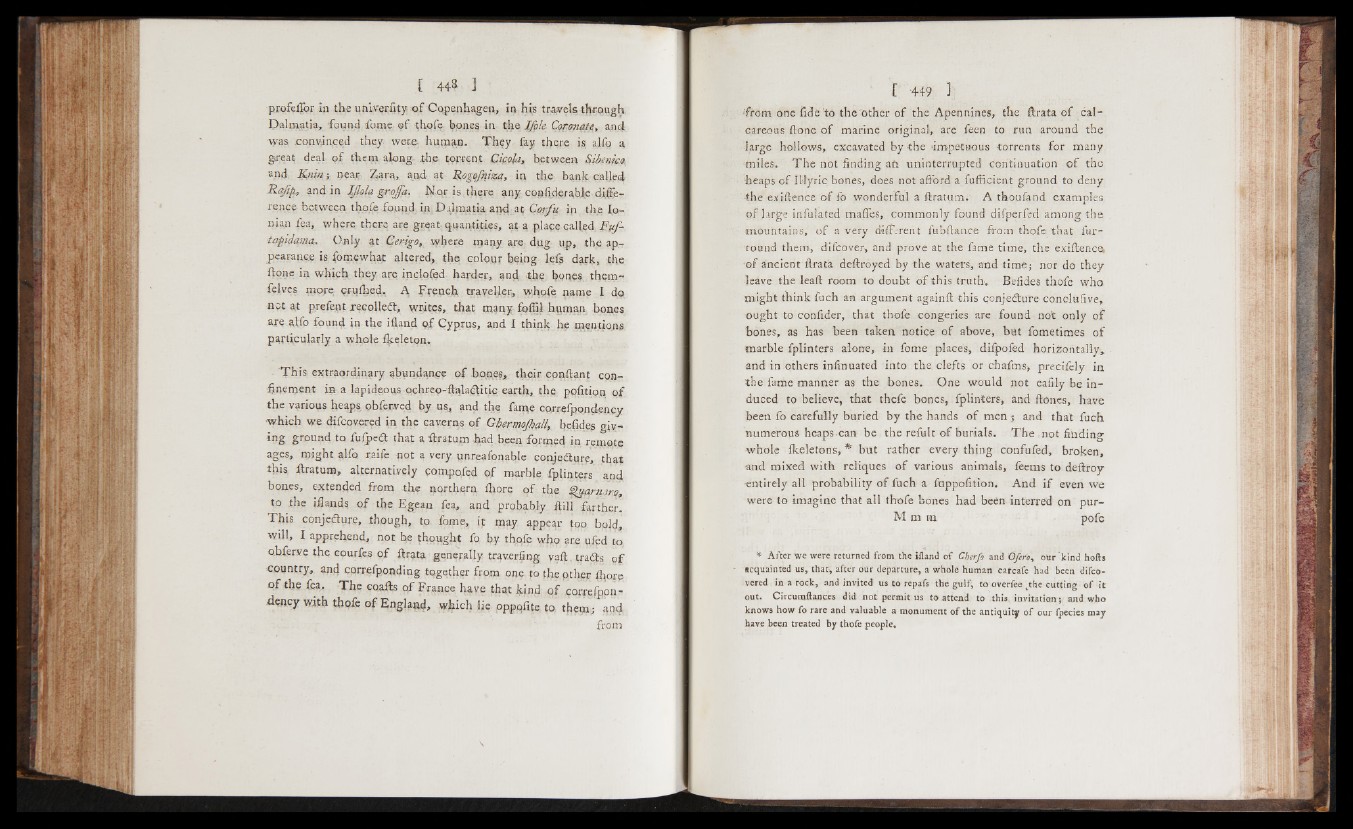
profeflor in the univerfity o f Copenhagen, in his travel^ through,
Dalmatia, found lbme of thole bones in. the I ffe . Coronate, and
vvas. convinced they were- human. They fay there is, ajfq a
great deal o f them along t-hg torrent Cfo/a, between Siknico,
and, Knin; neat Zara, and at Iipgqfniza, in th,e bank called
R a ff, and in IJlola grofa. h.'or is there any coniiderabJe difference
between thofe found in Dalmatia and at Corfu in the Ionian
fea, where there are grgat quantities, at a place called FttJ-
tapdama. Only at Cerigo, where marry are dug up, the appearance
is fomewhat altered, the colour being left dark, the
ftone in which they are inclqfed harder, and the hongs, them-
felves more crqihed, A French traveller, whofe n,arne I do
not at prefept recoiled, writes, that many foifil human bones
arc alfo found in the ifland o f Cyprus, and I think hg ipgntjons
particularly a whole ikeleton.
This extraordinary abundance o f bo.nes, their cpnftant confinement
in a lapideous o.chrep-ftqlaCtitic eartk, the ppfition o f
the various heaps obferved by us, and the faiqe correfpondency
which we difcovered in the caverns of Ghermojhall, befides giving
ground to fu/peCt that a ftratum had been formed in remo.te
ages, might iftfo raife not a very unreafppahle coiqeCturp, that
this ftratum, alternatively compqfed o f marble fplinters and
bones, extended from the northern fljorg qf the Sfuqrmr.Q,
to the iflands o f the Kgeau fea, and probably ftill farther*
This conjecture, though, to forne, if may appear top b,o}d,
Will, I apprehend, not he thought fo by thofe whq ?rg pled to
ohferve the courfes o f ftratg. generally traverfing yalf, traCis o f
country, and cprrefponding together from one fo fjhe qthgr fh°fPi
o f the fea. The coalts o f France have that hind o f qorrefppn-
dency with thofe o f England, which lie oppqfite to them; and
from
from one fide to the other o f the Apennines, the Strata o f calcareous
ftone o f marine original, are feen to run around the
large hollows, excavated by the impetuous torrents for many
miles. The not finding an uninterrupted continuation o f the
heaps o f Illyric bones, does not afford a fufficient ground to deny
-the exiftence of fo wonderful a ftratum.' A thoufand examples
of large infulated mafies, commonly found difperfed among the
mountains, of a very different fubftance from thofe that fur-
round them, difcover, and prove at the fame time, the exiftencet
o f ancient ftrata deftroyed by the waters, and time; nor do they
leave the lead room to doubt of this truth. Befides thofe who
might think fuch an argument againft this conjecture conc-lufive,
ought to confider, that thofe congeries are found not only o f
bones, as has been taken notice o f above, but fometimes of
marble fplinters alone, in fome places, dilpoled horizontally,
and in others infinuated into the clefts or chaftns> precifely in
the fame manner as the bones. One would not eafily be induced
to believe, that thefe bones, fplinters, and ftones, have
been fo carefully buried by the hands o f men ; and that fuch
numerous heaps can be the refult o f burials. The not finding
whole Skeletons, * but rather every thing confufed, broken,
and mixed with reliques o f various animals, feems to deftroy
-entirely all probability o f filch a fuppofition. And i f even we
were to imagine that all thofe bones had been interred on pur-
M m m pofe
* After we were returned from the ifland of Cherfo and Ofero, our kind holts
acquainted us, that, after our departure, a whole human carcafe had been difcovered
in a rock, and invited us to repafs the gulf, to overfee ^the cutting o f it
out. Circumftances did not permit us to attend to this invitation; and who
knows how fo rare and valuable a monument o f the antiquity of our Ipecies may
have been treated by thofe people.